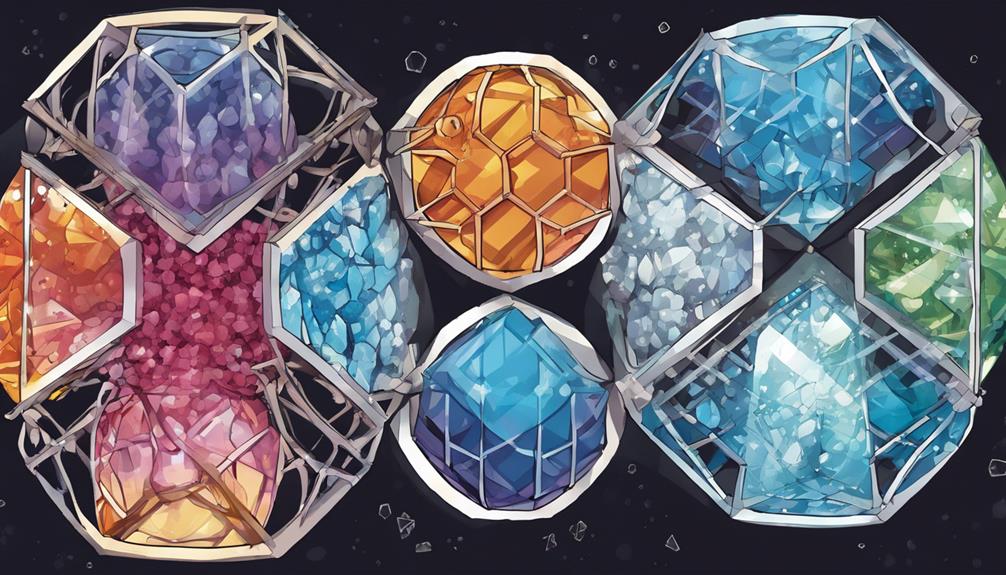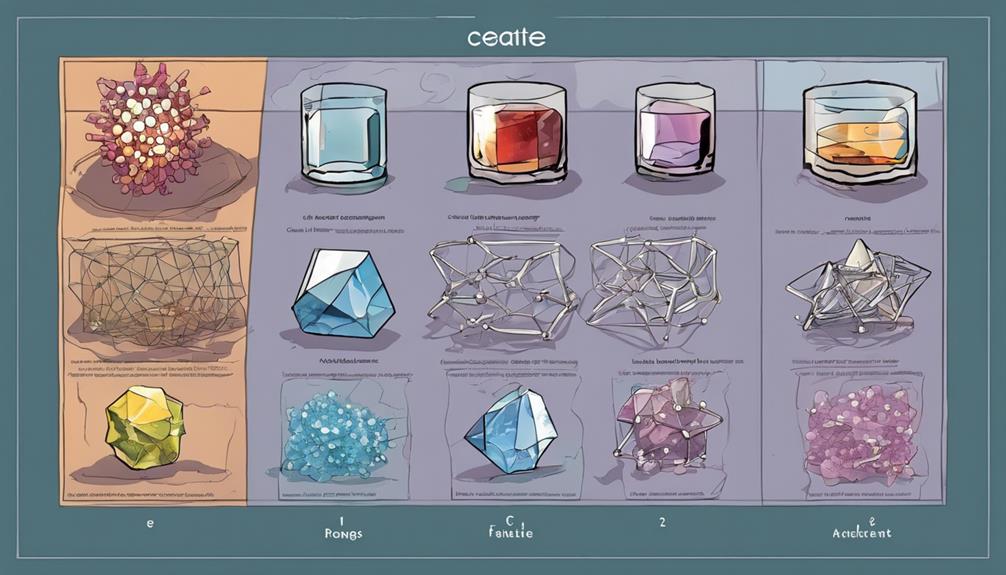Based on the table, the best-supported statement about crystal lattice energy is that the interplay between ion size, charge, and crystal lattice arrangement is essential for grasping the intricate nature of lattice energy. Understanding these factors is vital to predicting and deciphering the complexities of lattice energy behavior. As you explore further, you'll uncover how these elements interact to influence the stability and properties of ionic compounds.
Key Takeaways
- Crystal lattice energy increases with higher charges of cations and anions.
- Lattice energy is inversely related to ion size; smaller ions result in higher lattice energy.
- The arrangement of ions in the crystal lattice impacts the strength of ionic bonds and lattice energy.
- Born-Haber cycle aids in predicting lattice energies by considering factors like ionization energy and electron affinity.
- Understanding ion size, charge, and crystal lattice structure is crucial for predicting and comparing lattice energies accurately.
Crystal Lattice Energy Overview
Understanding crystal lattice energy is important for grasping the stability and properties of ionic compounds. In the context of crystal lattice energy, the energy required to break apart 1 mole of an ionic solid into gaseous ions is necessary.
The lattice energy increases as the charges of the cations and anions increase. This statement about crystal lattice energy is supported by the data shown in the table, where compounds with smaller, highly charged ions exhibit higher lattice energies.
Conversely, when ions are larger or carry lower charges, the lattice energy decreases. This inverse relationship between ion size and lattice energy is a fundamental aspect of crystal lattice energy.
The variations in lattice energy play a significant role in determining the structure and properties of ionic compounds. For instance, compounds with high lattice energies tend to form rigid, crystalline structures with elevated melting points.
As a result, the interplay between ion charges, sizes, and crystal lattice structure ultimately governs the crystal lattice energy dynamics observed in ionic compounds.
Factors Affecting Lattice Energy

Several factors, including ion size, charge, and crystal lattice arrangement, play an important role in determining the lattice energy of a compound. The energy increases as cations become smaller and carry higher charges. This is supported by the information shown by LiF and NaCl, where the lattice energy is best when ions are smaller and have higher charges.
Additionally, the crystal lattice arrangement influences the strength of the ionic bonds, impacting the overall lattice energy. As the distance between ions decreases in the crystal lattice, the lattice energy increases. It's evident that the lattice energy is best when ions are closely packed in an orderly arrangement within the crystal lattice.
Understanding the effects of ion size, charge, and crystal lattice arrangement is essential in predicting and interpreting lattice energy values accurately.
Calculating Lattice Energies

To calculate lattice energies, you'll use a modified version of Coulomb's law that takes into account the charges of the ions. Understanding how ion charges influence lattice energy is essential in predicting physical properties of substances.
Lattice Energy Calculation
How do scientists calculate lattice energies for ionic solids?
Lattice energy, a key element in understanding the chemistry of elements, is determined by the energy needed to break apart 1 mol of an ionic solid into gaseous ions.
This energy varies, with calculated values falling in the range of 600 to 10,000 kJ/mol.
The lattice energy directly depends on the product of ion charges and is inversely proportional to the internuclear distance between ions.
By predicting and analyzing lattice energies, scientists can anticipate the stability and properties of ionic compounds.
These calculations provide valuable insights into the interactions within ionic solids, guiding researchers in explaining and manipulating the behavior of these materials in various chemical processes.
Understanding the intricacies of lattice energy calculation is essential for advancing the field of chemistry and harnessing the potential of ionic compounds in diverse applications.
Ion Charge Influence
In understanding how scientists calculate lattice energies for ionic solids, the influence of ion charges on the overall strength of the ionic bonds in a crystal is a fundamental factor to take into account.
Here are three key points to keep in mind regarding the impact of ion charges on lattice energy and ionic bonds:
- Higher Ion Charges: Higher charges on ions result in stronger electrostatic interactions between them, leading to higher lattice energies in the crystal structure.
- Calculated Values: The values for calculated lattice energies typically vary from 600 to 10,000 kJ/mol, with these values being greatly influenced by the charges of the ions involved.
- Relationship to Stability and Properties: The relationship between ion charges and lattice energy is essential in determining the stability and various properties exhibited by ionic compounds, showcasing the importance of ion charges in understanding crystal stability.
Physical Property Relationship
When calculating lattice energies for ionic solids, consider the relationship between physical properties and the energy required to break apart the solid into its gaseous ions.
The lattice energy is influenced by factors such as ion charges and internuclear distance. By multiplying the charges of the ions and inversely relating it to the distance between them, calculated values typically fall within the range of 600 to 10,000 kJ/mol.
This energy is pivotal in determining the properties and chemistry of ionic compounds, impacting their solubility, stability, and overall physical properties.
Understanding the crystal lattice's lattice energy aids in predicting how these substances will behave in various environments. By grasping this relationship between energy and physical properties, one can unravel the intricate nature of ionic solids and their reactions.
Crystal Structure Influence

The crystal structure greatly influences the lattice energy of a compound. When considering crystal lattice energy, the arrangement of ions within the structure plays a vital role. The number of anions coordinated to cations and vice versa is a key factor affecting the overall lattice energy.
Additionally, the size and charge of ions present in the crystal lattice significantly affect the lattice energy, as larger or more highly charged ions can lead to stronger interactions. Furthermore, in an ionic solid, the positive ions experience a delicate balance between attraction and repulsion forces from ions of both opposite and same charges, impacting the overall lattice energy.
Lastly, the Madelung constant values, which vary depending on the specific crystal lattice type, play a crucial role in determining the lattice energy of the compound. By considering these factors, one can gain a deeper understanding of how the crystal structure influences the lattice energy within an ionic solid.
Born-Haber Cycle Insights

You can now explore how the Born-Haber cycle aids in calculating lattice energies and predicting the stability of ionic compounds.
By employing equations from this cycle, you can anticipate the formation of specific ionic compounds based on their energy requirements.
Understanding these insights will provide valuable information on the factors influencing lattice energy values and the stability of various ionic compounds.
Lattice Energy Calculation
To understand the concept of lattice energy calculation through the Born-Haber cycle, it's essential to grasp the interplay of various energy factors involved in forming ionic compounds. The Born-Haber cycle provides a systematic approach to predicting and understanding the stability and properties of ionic compounds based on their lattice energies.
Here are three key insights to examine:
- Integration of Energy Factors: The Born-Haber cycle takes into account ionization energy, electron affinity, and sublimation energy to determine the lattice energy of an ionic compound accurately.
- Prediction of Stability: Lattice energy values obtained from the Born-Haber cycle assist in comparing the stability and strength of different ionic bonds in crystal structures.
- Impact on Properties: The Born-Haber cycle serves as a fundamental tool in studying crystal lattice energy trends and understanding how they influence the physical and chemical properties exhibited by ionic compounds.
Ionic Compound Stability
Understanding the principles of the Born-Haber cycle provides valuable insights into the stability of ionic compounds. In the context of ionic compound stability, lattice energies play a pivotal role. The energy is best supported in compounds with small, highly charged ions due to the strong electrostatic forces they exhibit.
As cations increase in size, lattice energies tend to decrease due to weaker interactions resulting from larger ion sizes. Ion charges also greatly influence lattice energy, with higher charges leading to higher lattice energies, indicating greater stability in the compound. This trend is vital in predicting the stability of different ionic compounds.
Lattice Energy Prediction
When analyzing lattice energy prediction through insights from the Born-Haber cycle, you can accurately forecast the stability of ionic compounds. The Born-Haber cycle provides a systematic approach to predict the lattice energy and overall stability of these compounds.
By examining the charges of ions and their sizes, you can make informed predictions about the magnitude of lattice energy in a crystal lattice.
Here are three key aspects to take into account when predicting lattice energy in the formation of ionic compounds:
- Charge of Ions: Higher charges on ions lead to stronger electrostatic interactions, resulting in higher lattice energies and increased stability.
- Ion Size: Smaller ions create closer packing in the crystal lattice, enhancing electrostatic forces and raising lattice energy for improved stability.
- Formation of Compounds: Equations derived from the Born-Haber cycle enable the prediction of specific ionic compound formations by considering the energy changes throughout the process.
Lattice Energies and Properties

Lattice energies play a pivotal role in determining the properties of ionic compounds, such as their melting points and ionic bond strength. The magnitude of lattice energy is directly related to the strength of the ionic bonds within a compound. Factors like ion charge, ion size, and crystal lattice structure influence the lattice energy, impacting the compound's overall stability. The Born-Haber cycle is a valuable tool for calculating lattice energies and predicting the stability of ionic compounds. Understanding these energies is crucial for predicting the solubility, conductivity, and other properties of ionic substances.
| Factors | Influence on Lattice Energy | Impact on Properties |
|---|---|---|
| Ion Charge | Directly proportional | Higher stability |
| Ion Size | Inversely proportional | Alters lattice structure |
| Crystal Structure | Varied influence | Affects overall properties |
Impact of Lattice Energies

The impact of lattice energies on the properties of ionic compounds is substantial, influencing various characteristics such as melting points and conductivity. Understanding how lattice energy affects ionic solids and their behaviors is essential for predicting their properties accurately.
Here are three key points to keep in mind:
- Ion Charges and Lattice Energy: The magnitude of the charges on the ions forming the ionic solid directly impacts the lattice energy. Higher charges lead to stronger attractions between ions, resulting in higher lattice energies.
- Distance Between Ions and Lattice Energy: The distance between the ions within the crystal structure also plays a crucial role in determining the lattice energy. Shorter distances between ions lead to stronger interactions and higher lattice energies.
- Madelung Constant Influence: The choice of crystal structure, influencing the Madelung constant, significantly impacts the calculated lattice energy. Different crystal structures can result in varying lattice energies, impacting the overall properties of the ionic compound.
Gauth AI Analysis

Gauth AI's analysis provides valuable insights into the correlation between ion charges, sizes, and lattice energy in ionic compounds. By examining compounds like LiF, KF, LiCl, NaCl, and NaF, a clear relationship between ion properties and lattice energy emerges. Specifically, the data highlights that compounds with smaller cations tend to exhibit higher lattice energy. This trend underscores the importance of ion charges and sizes in determining the strength of ionic bonds within crystal lattices.
Understanding these relationships is essential for predicting the crystal strength of different ionic compounds. As seen in the examples provided, higher ion charges and smaller ion sizes generally result in higher lattice energies. This information aids in comprehending the stability and structural integrity of ionic solids.
Hence, Gauth AI's analysis sheds light on the fundamental factors influencing lattice energy and, consequently, the overall strength of ionic bonds in crystal structures.
Crystal Lattice Energy Trends

When comparing different ionic compounds, the trend of higher lattice energy correlating with smaller cations becomes evident. This trend is supported by the observations in compounds such as LiF, NaF, LiCl, and NaCl.
Here are three key points to deepen your understanding:
- LiF, with a smaller cation (Li+), exhibits higher lattice energy compared to KF, showcasing the impact of a smaller cation on lattice energy.
- LiCl, containing a larger cation (Li+), demonstrates lower lattice energy than LiF, emphasizing the inverse relationship between cation size and lattice energy.
- NaF, with a smaller cation (Na+), displays higher lattice energy than NaCl, illustrating once again the trend of smaller cations leading to higher lattice energy.
Frequently Asked Questions
Which Statement About Crystal Lattice Energy Is Best Supported by the Information in the Table Brainly?
In the table, you'll find details on crystal lattice energy. Remember, as cations shrink, lattice energy increases. Comparing LiF to KF highlights this trend. Analysis links lattice energy to ion size, with higher charges and smaller sizes boosting it.
Which Statement Is True About Crystal Lattice Energy?
Just like a sturdy fortress, crystal lattice energy fortifies ionic compounds. It directly links to the strength of ionic bonds. Understanding trends in lattice energy is crucial for predicting properties of ionic substances.
Which Statement Is True About Crystal Lattice Energy Quizlet?
To understand crystal lattice energy, recognize factors like ion charges and distance between ions. These influence the strength of ionic bonds in a crystal structure. By considering these elements, you can grasp the key role lattice energy plays in ionic compounds.
What Determines Crystal Lattice Energy?
You determine crystal lattice energy by considering factors like ion size, charge, and arrangement within the crystal structure. The strength of ionic bonds is quantified by lattice energy, with higher values indicating stronger bonds.
How Does Ion Charge Affect Crystal Lattice Energy as Supported by the Information in the Table?
The table clearly demonstrates how the charge of ions increase lattice energy. As the charge of the ions increases, the attraction between the ions and the lattice becomes stronger, resulting in higher lattice energy. This information highlights the direct correlation between ion charge and lattice energy in crystal structures.
Conclusion
Based on the information provided in the table, it's clear that crystal lattice energy is influenced by various factors such as ion size, charge, and distance between ions.
The trends in lattice energy can be seen through the calculated values, showcasing the importance of understanding these factors in predicting the properties of crystals.
So remember, next time you encounter a crystal lattice, think about the intricate dance of ions and energy that shape its structure.










